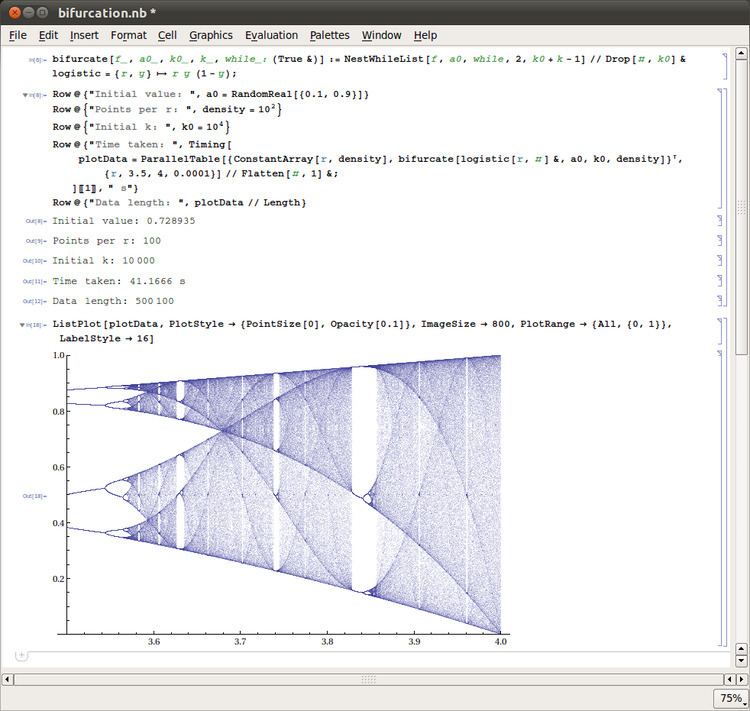 | ||
Initial release June 23, 1988; 28 years ago (1988-06-23) Stable release 11.1.0 (March 16, 2017 (2017-03-16)) [±] Platform Windows (7, 8, 10), macOS, Linux, Raspbian, online service. All platforms support 64-bit implementations. (list) Available in English, Chinese, Japanese | ||
Wolfram Mathematica (usually termed Mathematica) is a mathematical symbolic computation program, sometimes termed a computer algebra system or program, used in many scientific, engineering, mathematical, and computing fields. It was conceived by Stephen Wolfram and is developed by Wolfram Research of Champaign, Illinois. The Wolfram Language is the programming language used in Mathematica.
Contents
Features
Features of Wolfram Mathematica include:
The Notebook interface
Wolfram Mathematica is split into two parts, the kernel and the front end. The kernel interprets expressions (Wolfram Language code) and returns result expressions.
The front end, designed by Theodore Gray in 1988, provides a GUI, which allows the creation and editing of Notebook documents containing program code with prettyprinting, formatted text together with results including typeset mathematics, graphics, GUI components, tables, and sounds. All content and formatting can be generated algorithmically or edited interactively. Standard word processing capabilities are supported, including real-time multi-lingual spell-checking.
Documents can be structured using a hierarchy of cells, which allow for outlining and sectioning of a document and support automatic numbering index creation. Documents can be presented in a slideshow environment for presentations. Notebooks and their contents are represented as Mathematica expressions that can be created, modified or analyzed by Mathematica programs or converted to other formats.
The front end includes development tools such as a debugger, input completion, and automatic syntax highlighting.
Among the alternative front ends is the Wolfram Workbench, an Eclipse based integrated development environment (IDE), introduced in 2006. It provides project-based code development tools for Mathematica, including revision management, debugging, profiling, and testing. There is a plugin for IntelliJ IDEA based IDEs to work with Wolfram Language code which in addition to syntax highlighting can analyse and auto-complete local variables and defined functions. The Mathematica Kernel also includes a command line front end. Other interfaces include JMath, based on GNU readline and MASH which runs self-contained Mathematica programs (with arguments) from the UNIX command line.
High-performance computing
In recent years, the capabilities for high-performance computing have been extended with the introduction of packed arrays (version 4, 1999) and sparse matrices (version 5, 2003), and by adopting the GNU Multi-Precision Library to evaluate high-precision arithmetic.
Version 5.2 (2005) added automatic multi-threading when computations are performed on multi-core computers. This release included CPU specific optimized libraries. In addition Mathematica is supported by third party specialist acceleration hardware such as ClearSpeed.
In 2002, gridMathematica was introduced to allow user level parallel programming on heterogeneous clusters and multiprocessor systems and in 2008 parallel computing technology was included in all Mathematica licenses including support for grid technology such as Windows HPC Server 2008, Microsoft Compute Cluster Server and Sun Grid.
Support for CUDA and OpenCL GPU hardware was added in 2010. Also, since version 8 it can generate C code, which is automatically compiled by a system C compiler, such as GCC or Microsoft Visual Studio.
Deployment
There are several ways to deploy applications written in Wolfram Mathematica:
Connections with other applications
Communication with other applications occurs through a protocol called Wolfram Symbolic Transfer Protocol (WSTP). It allows communication between the Wolfram Mathematica kernel and front-end, and also provides a general interface between the kernel and other applications. Wolfram Research freely distributes a developer kit for linking applications written in the programming language C to the Mathematica kernel through WSTP. Using J/Link., a Java program can ask Mathematica to perform computations; likewise, a Mathematica program can load Java classes, manipulate Java objects and perform method calls. Similar functionality is achieved with .NET /Link, but with .NET programs instead of Java programs. Other languages that connect to Mathematica include Haskell, AppleScript, Racket, Visual Basic, Python and Clojure.
Links are available to many mathematical software packages including OpenOffice.org Calc, Microsoft Excel, MATLAB, R, SageMath (which can also pull up Mathematica), Singular, Wolfram SystemModeler, and Origin. Mathematical equations can be exchanged with other computational or typesetting software via MathML.
Communication with Structured Query Language (SQL) databases is achieved through built-in support for Java Database Connectivity (JDBC). Mathematica can also install web services from a Web Services Description Language (WSDL) description. It can access HDFS data via Hadoop.
Mathematica can call a variety of cloud services to retrieve or send data including ArXiv, Bing, ChemSpider, [[CrossRef", Dropbox,Facebook, Federal Reserve, Fitbit, Flickr, Google (Analytics, Calendar, Contacts, search, translate),Instagram, LinkedIn, MailChimp, MicrosoftTranslator]],Mixpanel, MusicBrainz, OpenLibrary, OpenPHACTS, PubChem, PubMed, Pushbullet, Reddit, RunKeeper, SeatGeek, SurveyMonkey, Twilio, Twitter, Wikipedia and Yelp.
Mathematica can capture real-time data via a link to LabVIEW, from financial data feeds and directly from hardware devices via GPIB (IEEE 488), USB and serial interfaces. It automatically detects and reads from HID devices.
Computable data
Wolfram Mathematica includes collections of curated data provided for use in computations. Mathematica is also integrated with Wolfram Alpha, an online service which provides additional data, some of which is kept updated in real time. Some of the data sets include astronomical, chemical, geopolitical, language, biomedical and weather data, in addition to mathematical data (such as knots and polyhedra).
Reception
BYTE in 1989 listed Mathematica as among the "Distinction" winners of the BYTE Awards, stating that it "is another breakthrough Macintosh application ... it could enable you to absorb the algebra and calculus that seemed impossible to comprehend from a textbook".
History
Wolfram Mathematica built on the ideas in Cole and Wolfram's earlier Symbolic Manipulation Program (SMP). The name of the program "Mathematica" was suggested to Stephen Wolfram by Apple cofounder Steve Jobs although Wolfram had thought about it earlier and rejected it.
